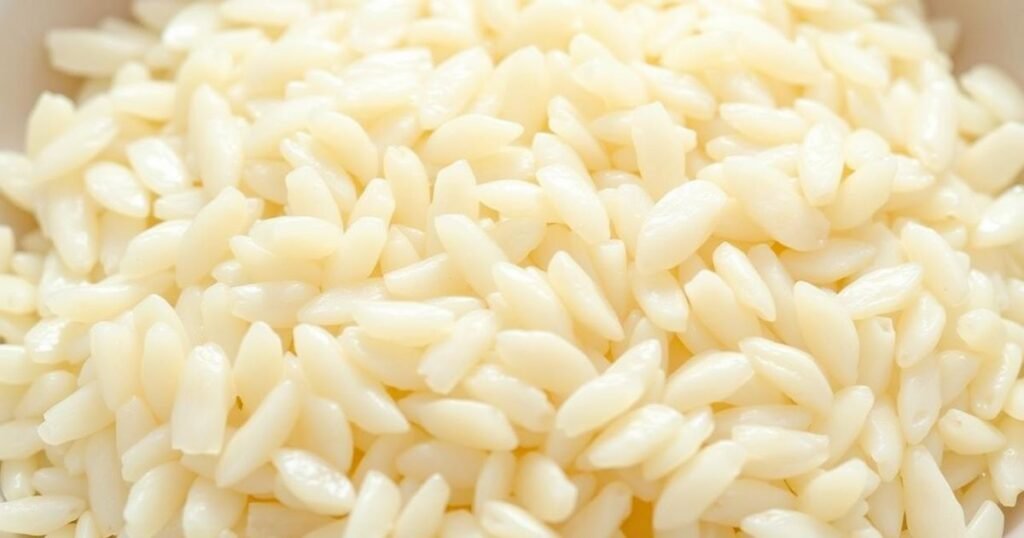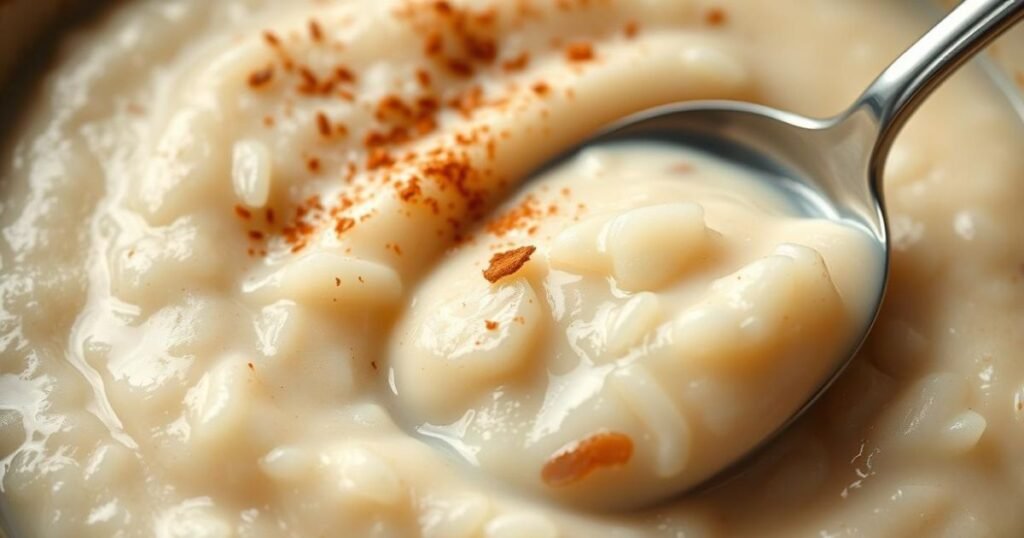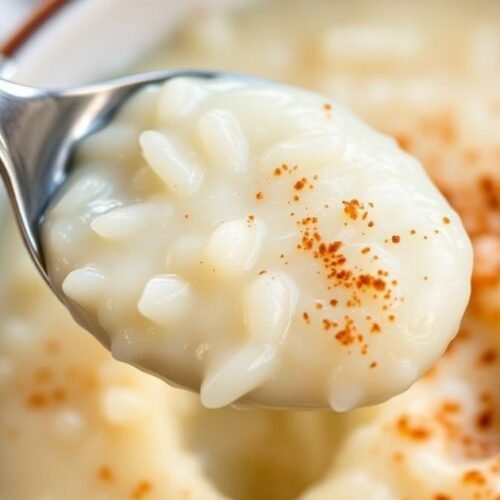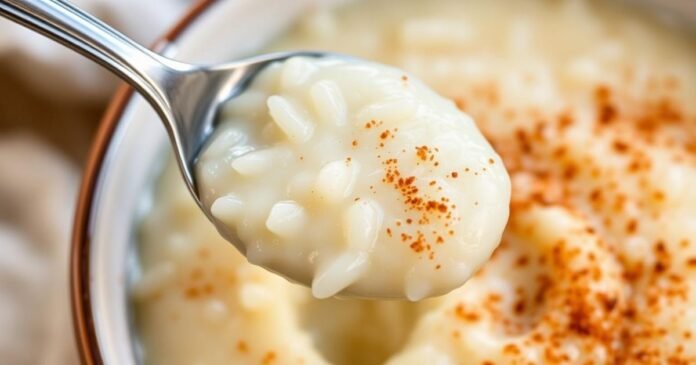Did you know rice-based desserts are found in almost every culture worldwide? From Indian kheer to Nordic risgrynsgröt, rice has been used in sweet dishes for over 2,000 years!
I’m excited to share this traditional rice pudding recipe with you today. It’s amazing how simple ingredients can turn into a warm, creamy treat. This classic dessert brings back childhood memories for many, including me.
This simple rice pudding recipe is easy to make because it only needs a few pantry staples. The magic happens as the grains simmer in sweetened milk. They release starch, making the pudding creamy.
Looking for a cozy treat or a dessert to share with family? This timeless classic is perfect. Even beginners will find it easy to make.
Ready to make the best rice pudding recipe you’ve ever had? Let’s get started!
Ingredients for a Perfect Rice Pudding
Every creamy bowl of rice pudding starts with a few simple ingredients. These pantry staples turn into a special dessert. Let’s look at each part to see how they make the perfect pudding.
You’ll need white rice, whole milk, sugar, salt, and vanilla extract. Each one is key to the creamy texture and sweetness we love. Let’s dive into each ingredient.
Rice: The Foundation of Your Pudding
The rice you choose is the base of your pudding. Medium grain rice is best for a creamy texture. It releases starch as it cooks, making the pudding creamy but not mushy.
Long-grain rice like jasmine or basmati adds a nice aroma. Even standard white rice works well if you’re in a hurry.
Cook the rice until it’s tender but still has a bit of bite. Brown rice can be used if you have leftover, but it needs more liquid and time.

Milk: Choosing the Right Type for Creaminess
The type of milk you use is crucial for creaminess. For the best results, use whole milk. It gives the pudding a rich, creamy texture.
Whole milk’s high fat content makes the pudding creamy. But you can use other milks too! 2% milk is good, though it’s less rich.
For less fat, skim milk works, but adding butter can help. For dairy-free options, almond, oat, or cashew milk are great. Oat milk, in particular, makes a creamy pudding.
When using any milk, add it slowly. This lets the rice absorb the liquid and become creamy.
Sugar and Salt: Balancing Sweetness and Flavor
Finding the right sweetness is key. I start with 1/3 cup of sugar for a balanced taste. This sweetness lets other flavors shine.
A pinch of salt is also important. It might seem small, but it enhances the flavor. Salt makes the vanilla and sweetness more complex.
Start with 1/4 cup of sugar if you prefer less sweetness. You can always add more, but you can’t take it away.
Try brown sugar, maple syrup, or honey for different flavors. Use about 25% less than sugar because they’re sweeter. Remember, you can always add more sweetener, but you can’t take it away.
Vanilla: The Essential Flavor Enhancer
Vanilla turns simple rice and milk into a memorable dessert. It adds a warm, aromatic quality. Use 1/2 teaspoon of vanilla extract, but adjust to taste.
Pure vanilla extract is the best choice. Add it at the end to keep its flavor. For a stronger flavor, use a vanilla bean. Scrape out the seeds and add them to the milk at the start.
Vanilla bean paste is a good middle ground. It offers the look of vanilla bean seeds with the ease of extract. Feel free to mix in other extracts for unique flavors. Vanilla is what makes rice pudding special.
Step-by-Step Guide to Making Rice Pudding
Making rice pudding from scratch is rewarding. It fills your kitchen with great smells and gives you a creamy, comforting dessert. This classic treat needs just a few ingredients but is very satisfying. It turns simple pantry items into something special in about 20 minutes.
This rice pudding recipe is easy because it doesn’t need eggs. Traditional recipes often use eggs, which can be tricky. Our method avoids this problem and still gives you a rich, creamy texture.
Combining Ingredients in a Saucepan
You can start with uncooked rice or leftover rice. Both ways make delicious pudding, but they have different textures.
To start with uncooked rice, boil 1½ cups of water in a medium saucepan. Add ¾ cup of white rice, then lower the heat to low. Cover and simmer until the rice is tender, about 15-20 minutes.
For leftover rice, use about 3 cups of cooked white rice. This saves time and gives leftover rice a new life.
Once your rice is ready, move it to a bigger, heavy-bottomed saucepan. Add 2 cups of milk, ⅓ cup of sugar, and ¼ teaspoon of salt. A heavy-bottomed pan is crucial for preventing scorching, which can happen quickly with milk-based recipes.
Stir everything together until well combined. Make sure all ingredients are mixed well before moving on.
Simmering for the Perfect Texture
The next step is the simmer that turns your ingredients into creamy rice pudding. Place your saucepan over medium heat and bring the mixture to a gentle simmer.
Don’t rush this part! Keeping the heat at medium to medium-low prevents scorching and helps the rice release its starches. Stir frequently, especially as it thickens. Use a wooden spoon to prevent scratching your pan.
The simmering process takes about 15-20 minutes. You’ll see your mixture change from milky to thick and creamy.
To check if it’s done, see if the pudding coats the back of your wooden spoon. If you run your finger through it, the line should hold for a moment before slowly filling in. Remember that pudding thickens as it cools, so it’s better to err on the slightly loose side.
If it thickens too fast, lower the heat and add a bit more milk. Patience during this stage is key to getting that perfect texture.
Adding Richness with Butter and Vanilla
The final touches make your rice pudding exceptional. Once it’s thick enough, remove it from the heat and add the finishing touches.
First, add a tablespoon of butter and stir until it’s fully melted and mixed in. This small addition adds remarkable richness and a silky mouthfeel.
Next, stir in ½ to 1 teaspoon of vanilla extract. Adding vanilla at the end preserves its delicate aromatic qualities that might otherwise cook off during simmering. This essential flavor enhancer brings warmth and depth to your dessert.
This is your chance to adjust the flavor. Need more sweetness? Add another tablespoon of sugar. Want more vanilla? A few more drops of extract will do the trick.
Give everything one final, thorough stir to ensure all these finishing touches are evenly distributed. The residual heat helps meld these final flavors together beautifully, creating a harmonious, comforting dessert ready to be enjoyed.
Whether you serve it warm right away or chill it for later, your homemade rice pudding will have that perfect balance of creamy texture and comforting flavor. And the best part? You created it in just about 20 minutes of active cooking time!
Customizing Your Rice Pudding Recipe
Rice pudding is more than just creamy comfort. It’s a canvas for your creativity. Once you know the basic recipe, you can make it your own.
Adding dried fruits is a classic move. Mix in 1/2 cup of raisins or sultanas for the last 5 minutes. They’ll soften and sweeten your dessert.
Warm spices can make your pudding special. Here are some options:
- Cinnamon – Add 1/4 teaspoon while cooking or sprinkle on top before serving
- Nutmeg – A pinch grated fresh adds wonderful aroma
- Cardamom – 1/4 teaspoon ground for an exotic twist
- Vanilla bean – Split and scraped instead of extract for intense flavor
For a different texture, try baking your pudding. Put the stovetop mix in a buttered dish, add cinnamon sugar, and bake at 350°F for 20 minutes. You’ll get a creamy inside and caramelized top.
On busy days, use a slow cooker. Mix 1 cup rice, 4 cups milk, 1/2 cup sugar, and a teaspoon of vanilla. Cook on low for 2-3 hours, stirring occasionally. It’s easy and perfect!
For special occasions, add luxurious ingredients:
- A splash of rum or bourbon (added after cooking)
- Dark or white chocolate chips folded in while still warm
- Fresh berries gently mixed in just before serving
- A drizzle of salted caramel sauce over the top
Explore international rice pudding variations. Scandinavian versions have fruit jam, Indian kheer has cardamom and pistachios, and Mexican pudding has cinnamon sticks and star anise.
Try different rice types, too. Arborio rice makes it extra creamy, while brown rice adds nutty flavor and fiber. Just remember, brown rice takes longer to cook.
Homemade rice pudding lets you control everything. You can change the sweetness, add-ins, and cooking method. Each batch is a new adventure in flavor!
Serving and Storing Your Homemade Rice Pudding
After making your rice pudding, knowing how to serve and store it is key. It’s great because you can serve it warm, at room temperature, or cold. This lets you enjoy it at its best, whether now or later.
Serving Suggestions: Warm or Cold?
The traditional rice pudding recipe is very flexible. You can serve it warm, at room temperature, or chilled. Each way brings out different flavors and textures.
Warm rice pudding is cozy and comforting. It smells like vanilla and feels like a hug. At room temperature, it’s sweeter and firmer.
Chilled rice pudding is like ice cream. It’s refreshing and has strong flavors. It thickens a lot as it cools, so make it a bit looser if you plan to chill it.
For a fancy look, serve it in glasses or ramekins. Add cinnamon, maple syrup, or berries for a pop of color. A “rice pudding bar” lets everyone customize their dessert.
Storing Leftovers for Later Enjoyment
Rice pudding keeps well and often tastes better after a day in the fridge. Cool it down to room temperature before storing it in an airtight container. Always keep dairy desserts refrigerated within two hours.
It stays good in the fridge for up to five days. It will firm up as it cools, but that’s okay. Just reheat it when you’re ready.
To reheat, warm it in a saucepan over low heat with a bit of milk. Stir often until it’s right. Or, microwave it in 30-second bursts, stirring and adding milk as needed.
Use leftover rice to make rice pudding. It’s a great way to reduce waste and make a tasty dessert. Some say pudding made with leftover rice tastes better!

Nutritional Information and Dietary Considerations
The simple ingredients in traditional rice pudding make it comforting and fit for many diets. It’s a treat that balances indulgence with nutrition. This makes it great for different eating plans. Let’s look at what’s in your bowl of homemade goodness and how to make this simple rice pudding recipe fit your dietary needs.
Calorie Count and Macronutrient Breakdown
Knowing the nutritional profile of your rice pudding helps you enjoy it mindfully. A typical serving (about 1/2 cup) has about 200 calories. This number can change based on your ingredients.
Most of the calories come from carbs, mainly from the rice and sugar. Each serving has about 35-40g of carbs. The fat content is around 4-5g per serving when using whole milk. Using reduced-fat milk will slightly lower this number.
The protein, mostly from the milk, is about 5-6g per serving. This makes rice pudding more balanced than many desserts. When made with 2-3 cups of whole milk, it’s a good source of calcium.
The sodium is low, about 150mg per serving, mostly from a pinch of salt. The sugar content is around 15-17g per serving. This comes from added sugar and the natural sugars in milk.
If you’re watching your sugar intake, you can cut down the added sugar by 25-50%. This won’t greatly affect the overall flavor, especially with sweet toppings or mix-ins.
| Nutrient | Amount Per Serving | % Daily Value | Benefits |
|---|---|---|---|
| Calories | 198 | 10% | Energy source |
| Fat | 4.6g | 7.1% | Supports hormone production |
| Carbohydrates | 35.9g | 12% | Primary energy source |
| Protein | 5.8g | 11.6% | Tissue repair and growth |
| Fiber | 6.5g | 25.9% | Digestive health support |
Adapting the Recipe for Special Diets
Rice pudding is great because it’s easy to make for different diets without losing flavor. This rice pudding recipe no egg is especially good for those with egg allergies or dietary restrictions.
For a dairy-free or vegan diet, use your favorite plant-based milk. Oat milk makes it creamy, while almond or coconut milk add unique flavors. Keep in mind that non-dairy milks might need adjustments in cooking time.
To reduce sugar, cut it in half or use monk fruit sweetener, stevia, or erythritol. These work well in a rice pudding recipe slow cooker because the long cooking time blends the flavors.
For more protein, add unflavored or vanilla protein powder after cooking. Use higher-protein milk alternatives like soy or pea milk. Gluten-free diets don’t need changes, as rice is naturally gluten-free.
To increase fiber, use brown rice, but it needs more liquid and longer cooking time. For a paleo version, try cauliflower rice with coconut milk and honey or maple syrup.
Rice pudding is vegetarian and free from many allergens, including:
- Tree nuts (in its basic form)
- Gluten and wheat
- Shellfish and fish
- Eggs
- Peanuts
- Alcohol
This makes it a perfect dessert for gatherings with various dietary restrictions. With a few adjustments, everyone can enjoy this comforting classic.

Conclusion
Making this traditional rice pudding recipe is a rewarding experience. It only needs a few pantry staples to create a comforting dessert. The rice turns into a creamy treat that warms both body and soul.
This creamy rice pudding recipe is versatile. Enjoy it warm on cold nights or chilled in summer. You can add fresh berries for guests or keep it simple with cinnamon for a cozy night.
Rice pudding connects us to cooking traditions worldwide. Almost every culture has its own version, showing how much people love this dessert.
This simple rice pudding recipe might become your favorite comfort food. Stirring the pot, smelling the sweet aroma, and tasting that first creamy spoonful are all rewarding. It’s a cooking experience that’s as good as the dessert itself.
Try making this rice pudding at home. It’s easy, affordable, and sure to make everyone happy. Your kitchen will smell amazing, and you’ll have made something special from simple ingredients.
FAQ – Rice Pudding
What type of rice works best for rice pudding?
Medium grain rice like Arborio or Calrose is perfect for a creamy texture. These types release just the right starch while cooking. Long-grain rice, like jasmine or basmati, adds nice aromas. Standard white rice works well too.
The key is to cook the rice until it’s tender but still has a bit of bite.
Can I make rice pudding with leftover rice?
Yes! Using leftover rice is a great way to reduce waste. You’ll need about 3 cups of cooked rice. Add it to a saucepan with milk, sugar, and salt, then simmer as usual.
The cooking time might be shorter since the rice is already cooked. Stir frequently as it thickens.
Can I make rice pudding without eggs?
Yes! This recipe doesn’t use eggs, making it simpler and still creamy. Many recipes use eggs, which can be tricky. This version avoids that and still gets creamy from the rice’s starches.
How do I know when my rice pudding is done cooking?
It’s done when it coats the back of a wooden spoon. If you run your finger through it, the line should hold for a moment before filling in. It usually takes 15-20 minutes to simmer.
Remember, it will thicken as it cools, so aim for slightly loose rather than too thick.
Can I use non-dairy milk to make rice pudding?
Definitely! Unsweetened almond, oat, or cashew milk works great for dairy-free versions. Oat milk makes it especially creamy. Coconut milk adds a tropical flavor.
You might need to adjust cooking times since plant-based milks thicken differently.
Why is my rice pudding too thick or too thin?
If it’s too thick, add more milk slowly until it’s right. If it’s too thin, cook it a bit longer. It will thicken as it cools. For firm pudding, add milk when reheating.
How long does homemade rice pudding last in the refrigerator?
It lasts up to 5 days in the fridge, stored in an airtight container. Day-old pudding often tastes better as flavors meld. Always keep dairy desserts refrigerated for safety.
Can rice pudding be frozen?
Yes, but the texture might change when thawed. Freeze in airtight containers for up to 2 months. Thaw in the fridge and add milk to restore creaminess. Use leftover pudding in smoothies.
What are some good toppings or mix-ins for rice pudding?
Try raisins, cinnamon, and nutmeg for a classic taste. Fresh berries, bananas, or apples add freshness. Toasted nuts like almonds or pecans add crunch.
Maple syrup, honey, or caramel sauce sweeten it. A dollop of jam adds fruitiness. For adults, a splash of rum or bourbon adds depth.
Can I make rice pudding in a slow cooker?
Yes! A slow cooker recipe is easy and hands-off. Mix all ingredients, set on low for 2-3 hours, stirring if you can. The slow heat makes it creamy.

Homemade Rice Pudding Recipe
Ingredients
- 1½ cups water
- ¾ cup white rice medium grain preferred
- 2 cups whole milk or milk of choice
- ⅓ cup sugar adjust to taste
- ¼ teaspoon salt
- ½ to 1 teaspoon vanilla extract
- 1 tablespoon butter optional, for added richness
Instructions
- Cook the Rice
- Bring 1½ cups of water to a boil in a medium saucepan.
- Add ¾ cup of white rice, reduce heat to low, cover, and simmer for 15–20 minutes until the rice is tender.
- Combine Ingredients
- Transfer the cooked rice to a larger, heavy-bottomed saucepan.
- Add 2 cups of milk, ⅓ cup of sugar, and ¼ teaspoon of salt.
- Stir well to combine.
- Simmer
- Heat the mixture over medium heat until it reaches a gentle simmer.
- Stir frequently with a wooden spoon for 15–20 minutes until thick and creamy.
- Check if it coats the back of the spoon and leaves a trail when you run a finger through it.
- Finish
- Remove from heat.
- Stir in 1 tablespoon of butter and ½ to 1 teaspoon of vanilla extract.
- Adjust sweetness or vanilla to taste.
- Serve
- Serve warm, at room temperature, or chilled.
- Optional: top with cinnamon, fruits, or other mix-ins.
Notes
- Use medium grain rice for a creamy texture.
- Leftover rice can be used (about 3 cups cooked).
- Use a heavy-bottomed pan to avoid scorching.
- The pudding thickens as it cools—aim for a slightly loose texture while hot.
- For vegan or dairy-free options, use oat, almond, or cashew milk.
- Flavor add-ins include cinnamon, nutmeg, cardamom, vanilla bean, or rum.
- Store in the refrigerator for up to 5 days. Reheat with added milk if needed.
- Freeze for up to 2 months, but texture may change.
- Custom toppings like raisins, nuts, or jam can be added for variety.
- Great for special diets: egg-free, gluten-free, nut-free (basic version), and vegetarian.

